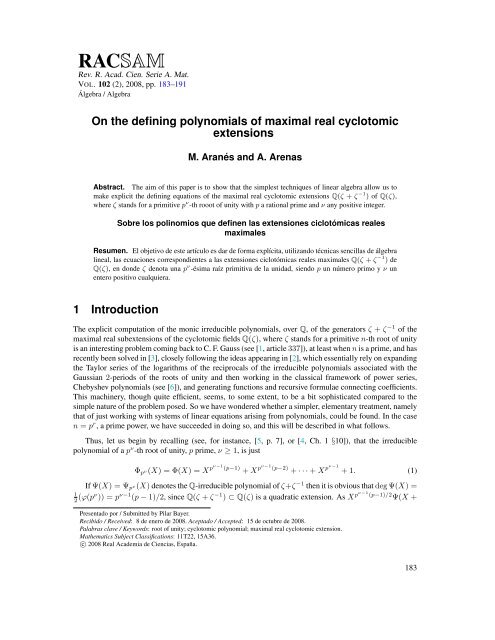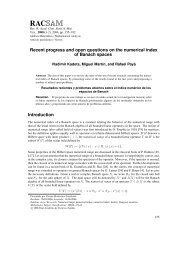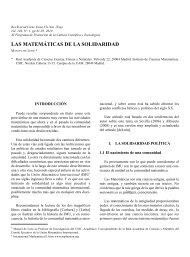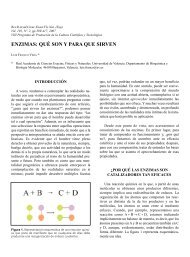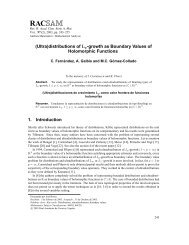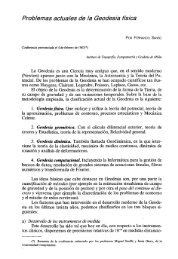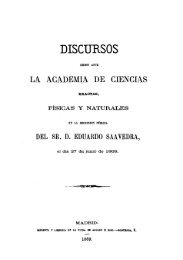On the defining polynomials of maximal real cyclotomic extensions
On the defining polynomials of maximal real cyclotomic extensions
On the defining polynomials of maximal real cyclotomic extensions
Create successful ePaper yourself
Turn your PDF publications into a flip-book with our unique Google optimized e-Paper software.
M. Aranés and A. ArenasX −1 ) is obviously a monic polynomial in X with rational coefficients, vanishing when X = ζ and <strong>of</strong>degree p ν−1 (p − 1), we see thatWe writeX pν−1 (p−1)/2 Ψ(X + X −1 ) = Φ(X) (2)Ψ p ν (X) = Ψ(X) = a m X m + a m−1 X m−1 + · · · + a 1 X + a 0 (3)where, <strong>of</strong> course a m = 1, and m = 1 2 ϕ(pν ) = p ν−1 (p − 1)/2.This paper is devoted to <strong>the</strong> evaluation <strong>of</strong> <strong>the</strong> coefficients a m−1 , . . . , a 1 , a 0 .2 PreliminariesIn order to achieve our aim we first proceed to expand <strong>the</strong> relation (2) using <strong>the</strong> notation <strong>of</strong> (3):⎛⎛⎞∑m (Φ(X) = X m a i X + 1 ) i m∑i∑(= a i X m−i ⎝ i2m∑∑(XX j)2(i−j) ⎠ = ⎜i⎝ a iji=0i=0j=0t=0i−2j=t−m0≤j≤i≤m⎞)⎟⎠ Xt .This shows that a 0 , . . . , a m is a solution <strong>of</strong> <strong>the</strong> system <strong>of</strong> linear equations∑( ) ia i = b t , (4)ji−2j=t−m0≤j≤i≤mwhere by (1), for 0 ≤ t ≤ ϕ(p ν ) = 2m,⎧⎨1, if t = p ν−1 l, 0 ≤ l < pb t =⎩0, o<strong>the</strong>rwise,For <strong>the</strong> sake <strong>of</strong> clarity we rewrite <strong>the</strong> preceding system <strong>of</strong> equations (4) more explicitly as follows:⎧k/2∑( )m − k + 2ja m−k+2j , for k = 2, 4, . . . , r.⎪⎨jj=0b 2m−k =(5)(k−1)/2∑( )m − k + 2j⎪⎩a m−k+2j , for k = 1, 3, . . . , s.jj=0where r = m, s = m − 1, if p ≡ 1 (mod 4) or p = 2; and r = m − 1, s = m in <strong>the</strong> case p ≡ 3 (mod 4).In order to get <strong>the</strong> explicit solution <strong>of</strong> (5) we are led to compute <strong>the</strong> following determinants <strong>of</strong> order k,for strictly positive integers r, k:( r+2(k−1)) ( r+2(k−2))100 0 · · · · · · 0( r+2(k−1)) ( r+2(k−2)) ( r+2(k−3))2100 · · · · · · 0. .... .. .A r (k) :=....... ..... 0( r+2(k−1)) ( r+2(k−2)) ( r+2(k−3)) ( r+2(k−4))( k−1k−2k−3k−4· · · · · · r ( 0)∣ r+2(k−1)) ( r+2(k−2)) ( r+2(k−3)) ( r+2(k−4))(kk−1k−2k−4· · · · · · r 1)∣184
Defining <strong>polynomials</strong> <strong>of</strong> <strong>maximal</strong> <strong>real</strong> <strong>cyclotomic</strong> <strong>extensions</strong>for k ≥ 2, and A r (1) := ( r1)= r.Obviously A 1 (k) = 0, for all k ≥ 2 (since <strong>the</strong>re appear two equal rows in such a case), and <strong>the</strong>remaining cases are covered by <strong>the</strong> followingLemma 1 For r ≥ 2, and k ≥ 2, we havePROOF.This follows from <strong>the</strong> equality( r+2k−31( r+2(k−1)2.A r (k) =..( r+2(k−1)k−1(∣ r+2(k−1)+∣kA r (k) = A r−1 (k) + A r (k − 1).) ( r+2k−50)) ( r+2(k−2)1.) ( r+2(k−2)k−2( r+2(k−1)( r+2(k−1)k−1( r+2(k−1)k) ( r+2(k−2)k−1..) ( r+2(k−3)0) ( r+2(k−3)k−3) ( r+2(k−3)k−20 0 · · · · · · 0)0 · · · · · · 0... .. ...... ... 0) ( r+2(k−4))( k−4· · · · · · r 0)) ( r+2(k−4))(k−3· · · · · · r 1)∣1 0 0 · · · · · · 0) ( r+2(k−2))100 · · · · · · 0. ... .. .. ..... 0,) ( r+2(k−2)) ( r+2(k−3))( k−2k−3· · · · · · r 0)) ( r+2(k−2)) ( r+2(k−3))(k−1k−2· · · · · · r ∣1)obtained by performing in <strong>the</strong> first determinant successive subtractions <strong>of</strong> each row to <strong>the</strong> following one,starting from above. We will define A r (0) = 1, for r ≥ 2, and by convention we will consider ( ij)= 0 ei<strong>the</strong>r if i < j or ifi < 0. With <strong>the</strong>se notations it is easy to establish <strong>the</strong> followingTheorem 1 For any strictly positive integers r, k, we have( ) ( )r + k − 2 r + k − 3A r (k) =+kk − 1PROOF. From Lemma 1 we deduce that <strong>the</strong> A r (k) are easily computed by adding two Pascal triangles,namely <strong>the</strong> usual one with that obtained by shifting <strong>the</strong> usual Pascal triangle by means <strong>of</strong> adding an edge <strong>of</strong>zeros on <strong>the</strong> left sloping side. This immediately yields <strong>the</strong> result. 3 Evaluation <strong>of</strong> <strong>the</strong> coefficientsNext we give explicit expressions for <strong>the</strong> coefficients a i in terms <strong>of</strong> what we have introduced in <strong>the</strong> precedingsection.Theorem 2 The coefficients a j <strong>of</strong> <strong>the</strong> polynomial Ψ p ν (X) are given by <strong>the</strong> following formulae:If p is odd,185
Defining <strong>polynomials</strong> <strong>of</strong> <strong>maximal</strong> <strong>real</strong> <strong>cyclotomic</strong> <strong>extensions</strong>Since b i = 1 for i = p ν−1 (p − 2), p ν−1 (p − 4), . . . , p ν−1 , and b i = 0 o<strong>the</strong>rwise, with our precedingnotations, by expanding <strong>the</strong> determinant according to its last column, we obtain( ) ( )m − j − pa j = (−1) (m−j−pν−1)/2 ν−1m − j − 3pA j+2 + (−1) (m−j−3pν−1)/2 ν−1A j+222( )m − j − kp+ · · · + (−1) (m−j−kpν−1)/2 ν−1A j+2 ,2for j satisfying m − kp ν−1 ≥ j ≥ m − (k + 2)p ν−1 , with k odd.Again from (5), we know that for j = 0, 2,. . . , m, <strong>the</strong> a j are <strong>the</strong> solution <strong>of</strong> <strong>the</strong> system <strong>of</strong> m/2 + 1linear equations( ) mb 2m =0Here Cramer’s rule yieldsb 2m−2 =.b m =( mm2a j =∣a m( m1)a m +)a m +( m0)..(mm−2−j2( m m−j2))( m − 20)a m−2( )( m − 20m−2a m−2 + · · · + a 020)∣0 · · · 0 b 2m ∣∣∣∣∣∣∣∣∣∣∣∣∣. .. . .. . .. .. 0 . ,(· · · · · · j+2)0b m+j+2)· · · · · · b m+jwhere b i = 1 for i = p ν−1 (p − 1), p ν−1 (p − 3), . . . , p ν−1 2, 0, and b i = 0 o<strong>the</strong>rwise. It follows thata j = (−1) (m−j)/2 A j+2( m − j2( j+21) ( )m − j − 2p+ (−1) (m−j−2pν−1)/2 ν−1A j+2+ · · · + (−1) (m−j−kpν−1 )/2 A j+2( m − j − kpν−1for m − kp ν−1 ≥ j > m − (k + 2)p ν−1 , with k even.The same reasoning applies to <strong>the</strong> case p ≡ 3 (mod 4). From (5), it follows that, for j = 1, 3, . . . , m,<strong>the</strong> a j satisfy <strong>the</strong> system <strong>of</strong> linear equations( ) mb 2m = a m0( ) ( )m m − 2b 2m−2 = a m + a m−21 0.b m+1 =( ) mm−1a m +22),( )( m − 21m−3a m−2 + · · · + a 120)1872
M. Aranés and A. Arenaswhose discussion is just that <strong>of</strong> <strong>the</strong> case for j even, when p ≡ 1 (mod 4) and for j = 0, 2, . . . , m − 1,according to (5), <strong>the</strong> coefficients a j satisfy <strong>the</strong> following system <strong>of</strong> (m + 1)/2 equations:( ) m − 1b 2m−1 = a m−10( ) ( )m − 1m − 3b 2m−3 = a m−1 + a m−310.b m =( ) m − 1m−1a m−1 +2( )( m − 30m−3a m−3 + · · · + a 020)and here again <strong>the</strong> solution follows <strong>the</strong> lines for j odd in <strong>the</strong> case p ≡ 1 (mod 4).The preceding calculations carry over without any changes when p = 2 (and ν ≥ 3). Here <strong>the</strong> <strong>cyclotomic</strong>polynomial corresponding to a primitive 2 ν -th root <strong>of</strong> unity is X 2ν−1 + 1. Therefore, in this caseb i = 1 for i = 2 ν−1 and 0, and b i = 0 o<strong>the</strong>rwise. As now we have m = 2 ν−2 , <strong>the</strong> system <strong>of</strong> linear equationsfor <strong>the</strong> coefficients a j , with j odd, is homogeneous, so that all <strong>the</strong>se a j vanish. For <strong>the</strong> coefficientsa j , with j even, however, <strong>the</strong> system is just that <strong>of</strong> <strong>the</strong> case p ≡ 1 (mod 4) for j even, <strong>the</strong> only differencebeing that now only b 2m equals 1 while <strong>the</strong> o<strong>the</strong>r b i vanish, and hence as a result we get, for j even,( )a j = (−1) m−j m − j2 A j+2 .2Remark 1 Observe that a 0 may also be easily obtained by considering a simple alternate sum. Namely, ifp ≡ 1 (mod 4) as a 0 occurs in <strong>the</strong> system <strong>of</strong> equationsk/2∑( )m − k + 2jb 2m−k =a m−k+2j , k = 0, 2, 4, . . . 2m,jj=0by considering <strong>the</strong> alternate sum <strong>of</strong> <strong>the</strong>se equations we get 1 = (−1) m 2 a 0 , i.e., a 0 = (−1) m 2 = (−1) p−14 .The case p ≡ 3 (mod 4) is dealt with in exactly <strong>the</strong> same way and <strong>the</strong> result is a 0 = (−1) p−34 . Finally,when p = 2 and ν ≥ 3, we also apply <strong>the</strong> same method but now <strong>the</strong> alternate sum <strong>of</strong> <strong>the</strong> b i is 2 and <strong>the</strong>nwe get a 0 = −2 for ν = 3, and a 0 = 2 for ν > 3. In particular, if ζ is a primitive p ν th root <strong>of</strong> unity <strong>the</strong>nN(ζ + ζ −1 ) = ±1, if p is odd, and N(ζ + ζ −1 ) = ±2 if p = 2, ν ≥ 3.4 Numerical exemplesHere we list a few <strong>polynomials</strong> Ψ p ν (X) <strong>of</strong> degree less than 100. The <strong>polynomials</strong> have been computedwith Ma<strong>the</strong>matica, solving <strong>the</strong> system <strong>of</strong> equations given in (5).Ψ 2 3(X) = X 2 − 2Ψ 2 4(X) = X 4 − 4X 2 + 2Ψ 2 5(X) = X 8 − 8X 6 + 20X 4 − 16X 2 + 2188
Defining <strong>polynomials</strong> <strong>of</strong> <strong>maximal</strong> <strong>real</strong> <strong>cyclotomic</strong> <strong>extensions</strong>Ψ 2 6(X) = X 16 − 16X 14 + 104X 12 − 352X 10 + 660X 8 − 672X 6 + 336X 4 − 64X 2 + 2Ψ 2 7(X) = X 32 − 32X 30 + 464X 28 − 4032X 26 + 23400X 24 − 95680X 22 + 283360X 20− 615296X 18 + 980628X 16 − 1136960X 14 + 940576X 12 − 537472X 10 + 201552X 8− 45696X 6 + 5440X 4 − 256X 2 + 2Ψ 2 8(X) = X 64 − 64X 62 + 1952X 60 − 37760X 58 + 520144X 56 − 5430656X 54 + 44662464X 52− 296854272X 50 + 1623421800X 48 − 7398867840X 46 + 28362326720X 44− 92043777280X 42 + 254005423840X 40 − 597659820800X 38 + 1200442440064X 36− 2057901325824X 34 + 3006465218196X 32 − 3732682723968X 30+ 3922021702720X 28 − 3467892873984X 26 + 2561511781920X 24− 1565841089280X 22 + 782920544640X 20 − 315492902400X 18 + 100563362640X 16− 24754058496X 14 + 4559958144X 12 − 602516992X 10 + 53796160X 8− 2968064X 6 + 87296X 4 − 1024X 2 + 2Ψ 3 (X) = X + 1Ψ 3 2(X) = X 3 − 3X + 1Ψ 3 3(X) = X 9 − 9X 7 + 27X 5 − 30X 3 + 9X + 1Ψ 3 4(X) = X 27 − 27X 25 + 324X 23 − 2277X 21 + 10395X 19 − 32319X 17 + 69768X 15 − 104652X 13+ 107406X 11 − 72930X 9 + 30888X 7 − 7371X 5 + 819X 3 − 27X + 1Ψ 3 5(X) = X 81 − 81X 79 + 3159X 77 − 79002X 75 + 1423575X 73 − 19690290X 71 + 217468314X 69− 1969809516X 67 + 14915235753X 65 − 95752130760X 63 + 526771581336X 61− 2503875308688X 59 + 10348141674312X 57 − 37365688036656X 55+ 118311400286640X 53 − 329359817363616X 51 + 807564936805020X 49− 1745765378093205X 47 + 3328346338128315X 45 − 5594334252541650X 43+ 8281448901713295X 41 − 10779028729214130X 39 + 12307026638440170X 37− 12288575324139660X 35 + 10689623271729675X 33 − 8063030124961812X 31+ 5243788822527612X 29 − 2920409138472168X 27 + 1381487341784004X 25− 549663398587800X 23 + 181784104369560X 21 − 49257628280784X 19+ 10743691882671X 17 − 1844876383893X 15 + 242443079235X 13 − 23491379106X 11+ 1595093643X 9 − 70544682X 7 + 1813266X 5 − 22140X 3 + 81X + 1Ψ 5 (X) = X 2 + X − 1Ψ 5 2(X) = X 10 − 10X 8 + 35X 6 + X 5 − 50X 4 − 5X 3 + 25X 2 + 5X − 1Ψ 5 3(X) = X 50 − 50X 48 + 1175X 46 − 17250X 44 + 177375X 42 − 1357510X 40 + 8021650X 38− 37469900X 36 + 140512125X 34 − 427248250X 32 + 1059575660X 30 − 2148789800X 28+ 3562467300X 26 + X 25 − 4814145000X 24 − 25X 23 + 5272635000X 22 + 275X 21 189
M. Aranés and A. Arenas− 4639918800X 20 − 1750X 19 + 3241119750X 18 + 7125X 17 − 1767883500X 16− 19380X 15 + 736618125X 14 + 35700X 13 − 227613750X 12 − 44200X 11+ 50075025X 10 + 35750X 9 − 7400250X 8 − 17875X 7 + 672750X 6 + 5005X 5− 32500X 4 − 650X 3 + 625X 2 + 25X − 1Ψ 7 (X) = X 3 + X 2 − 2X − 1Ψ 7 2(X) = X 21 − 21X 19 + 189X 17 − 952X 15 + X 14 + 2940X 13 − 14X 12 − 5733X 11 + 77X 10+ 7007X 9 − 210X 8 − 5147X 7 + 294X 6 + 2072X 5 − 196X 4 − 371X 3 + 49X 2+ 14X − 1Ψ 11 (X) = X 5 + X 4 − 4X 3 − 3X 2 + 3X + 1Ψ 11 2(X) = X 55 − 55X 53 + 1430X 51 − 23375X 49 + 269500X 47 − 2330636X 45 + X 44+ 15696120X 43 − 44X 42 − 84366645X 41 + 902X 40 + 367982175X 39 − 11440X 38− 1317269525X 37 + 100529X 36 + 3899117794X 35 − 649572X 34 − 9586673914X 33+ 3196578X 32 + 19619239607X 31 − 12243264X 30 − 33417385705X 29 + 36984860X 28+ 47273371134X 27 − 88763664X 26 − 55309822425X 25 + 169695240X 24+ 53182431720X 23 − 258048959X 22 − 41656556260X 21 + 310465133X 20+ 26269293600X 19 − 292746091X 18 − 13133636571X 17 + 213285468X 16+ 5102112862X 15 − 117671620X 14 − 1499508714X 13 + 47797607X 12+ 321503053X 11 − 13737009X 10 − 47746996X 9 + 2634412X 8 + 4537511X 7− 306977X 6 − 241142X 5 + 18271X 4 + 5489X 3 − 363X 2 − 33X + 1Ψ 13 (X) = X 6 + X 5 − 5X 4 − 4X 3 + 6X 2 + 3X − 1Ψ 13 2(X) = X 78 − 78X 76 + 2925X 74 − 70226X 72 + 1212822X 70 − 16049124X 68 + 169258817X 66+ X 65 − 1461006690X 64 − 65X 63 + 10519248168X 62 + 2015X 61 − 64064084656X 60− 39650X 59 + 333510087768X 58 + 556075X 57 − 1496043894384X 56 − 5916638X 55+ 5817948478160X 54 + 49639590X 53 − 19705288218335X 52 − 336962340X 51+ 58324134324755X 50 + 1884328875X 49 − 151210718618596X 48 − 8793534750X 47+ 343882440712733X 46 + 34566585690X 45 − 686438430180555X 44− 115221952300X 43 + 1202538433766241X 42 + 327186864550X 41− 1847253500444352X 40 − 793766949499X 39 + 2484237427915958X 38+ 1647566693461X 37 − 2917993021435999X 36 − 2926078446954X 35+ 2984310576915395X 34 + 4441369064600X 33 − 2646952512165572X 32− 5747654035266X 31 + 2026059804050724X 30 + 6318342833374X 29− 1330313881030628X 28 − 5870129857956X 27 + 743866969521565X 26+ 4578698208045X 25 − 351127341416826X 24 − 2973173393775X 23+ 138436551316115X 22 + 1590288757005X 21 − 45002650983004X 20− 691411044090X 19 + 11871743606359X 18 + 240286948785X 17 − 2491355718306X 16190
Defining <strong>polynomials</strong> <strong>of</strong> <strong>maximal</strong> <strong>real</strong> <strong>cyclotomic</strong> <strong>extensions</strong>− 65341075696X 15 + 405458684553X 14 + 13521774841X 13− 49483859945X 12 − 2051360909X 11 + 4324257587X 10 + 216422271X 9− 252930808X 8 − 14656655X 7 + 8903427X 6 + 556387X 5 − 157001X 4− 9061X 3 + 1014X 2 + 39X − 1Acknowledgement. This paper has been partially supported by <strong>the</strong> research project MTM 2006–04895.References[1] GAUSS, C. F., (1801). Disquisitiones Arithmeticae, Leipzig. English translation by A. A. Clarke, S. J. NewHaven, Conn.: Yale Univ. Press, 1965 [= Werke Bd. 1], reprinted with corrections by Springer Verlag, 1987.[2] GUPTA, S. AND ZAGIER, D., (1993). <strong>On</strong> <strong>the</strong> coefficients <strong>of</strong> <strong>the</strong> minimal <strong>polynomials</strong> <strong>of</strong> Gaussian periods, Math.comp., 60, 385-398.[3] GURAK, S., (2006). Minimal <strong>polynomials</strong> for Gauss periods with f = 2, Acta Arith., 121, 233-257.[4] NEUKIRCH, J., (1999). Algebraic Number Theory, Grundlehren der ma<strong>the</strong>matischen Wissenschaften 322,Springer-Verlag, Berlin, Heidelberg and New York.[5] WASHINGTON, L. C., (1982). Introduction to Cyclotomic Fields, Springer-Verlag.[6] WATKINS, W. AND ZEITLIN, J., (1993). The minimal polynomial <strong>of</strong> cos(2π/n), Amer. Math. Monthly., 100,471–474.M. Aranés A. ArenasMa<strong>the</strong>matics Institute.Departament d’Àlgebra i Geometria.Zeeman Building.Facultat de Matemàtiques.University <strong>of</strong> Warwick.Universitat de BarcelonaCoventry CV4 7AL. Gran Via 585,United Kingdom.08007 Barcelona, Spain.M.T.Aranes@warwick.ac.uk angelaarenas@ub.edu191


